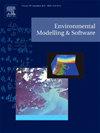Artificial intelligence-incorporated prediction for urban flooding processes in the past 20 years: A critical review
IF 4.6
2区 环境科学与生态学
Q1 COMPUTER SCIENCE, INTERDISCIPLINARY APPLICATIONS
引用次数: 0
Abstract
Urban flood forecasting is crucial for timely public warnings and effective flood management. Traditional mechanistic models face challenges such as high computational costs and limited real-time capabilities. Recent advancements in Artificial Intelligence (AI), including machine learning (ML), deep learning (DL), and large language models (LLMs), address these limitations by improving data handling, feature engineering, and forecasting accuracy. This review examines AI applications and evolution in urban flood forecasting, and features about commonly applied models such as convolutional neural networks (CNN), random forest (RF), long short-term memory (LSTM), and support vector machines (SVM). A comprehensive analysis compares various AI algorithms based on input parameters, output variables, forecasting lead time, and prediction accuracy. Key input parameters ("Rainfall," "Water depth," "Elevation") and output variables ("Inundation depth," "Inundation area," "Flow") were identified. Future research directions aim to enhance AI-driven forecasting precision for improved emergency response.

人工智能对过去20年城市洪水过程的预测:综述
城市洪水预报是及时预警和有效管理洪水的重要手段。传统的机械模型面临着诸如高计算成本和有限的实时能力等挑战。人工智能(AI)的最新进展,包括机器学习(ML)、深度学习(DL)和大型语言模型(llm),通过改进数据处理、特征工程和预测准确性来解决这些限制。本文综述了人工智能在城市洪水预报中的应用和发展,以及卷积神经网络(CNN)、随机森林(RF)、长短期记忆(LSTM)和支持向量机(SVM)等常用模型的特点。综合分析比较了基于输入参数、输出变量、预测前置时间和预测精度的各种人工智能算法。确定了关键输入参数(“降雨量”、“水深”、“海拔”)和输出变量(“淹没深度”、“淹没面积”、“流量”)。未来的研究方向是提高人工智能驱动的预测精度,以提高应急响应能力。
本文章由计算机程序翻译,如有差异,请以英文原文为准。
求助全文
约1分钟内获得全文
求助全文
来源期刊

Environmental Modelling & Software
工程技术-工程:环境
CiteScore
9.30
自引率
8.20%
发文量
241
审稿时长
60 days
期刊介绍:
Environmental Modelling & Software publishes contributions, in the form of research articles, reviews and short communications, on recent advances in environmental modelling and/or software. The aim is to improve our capacity to represent, understand, predict or manage the behaviour of environmental systems at all practical scales, and to communicate those improvements to a wide scientific and professional audience.
 求助内容:
求助内容: 应助结果提醒方式:
应助结果提醒方式:


